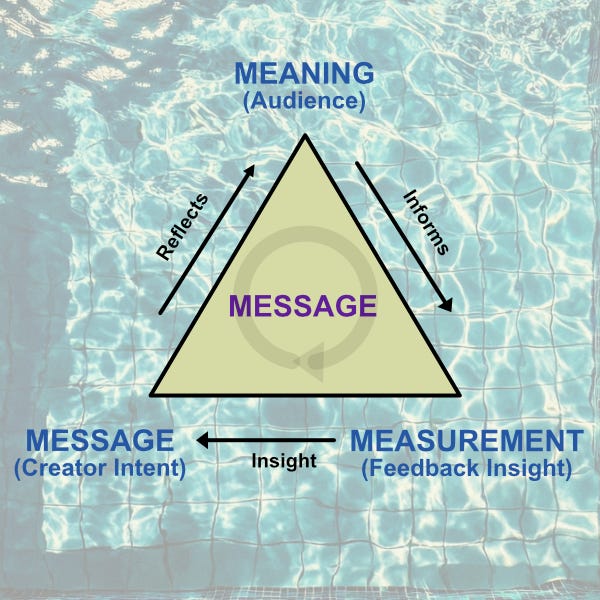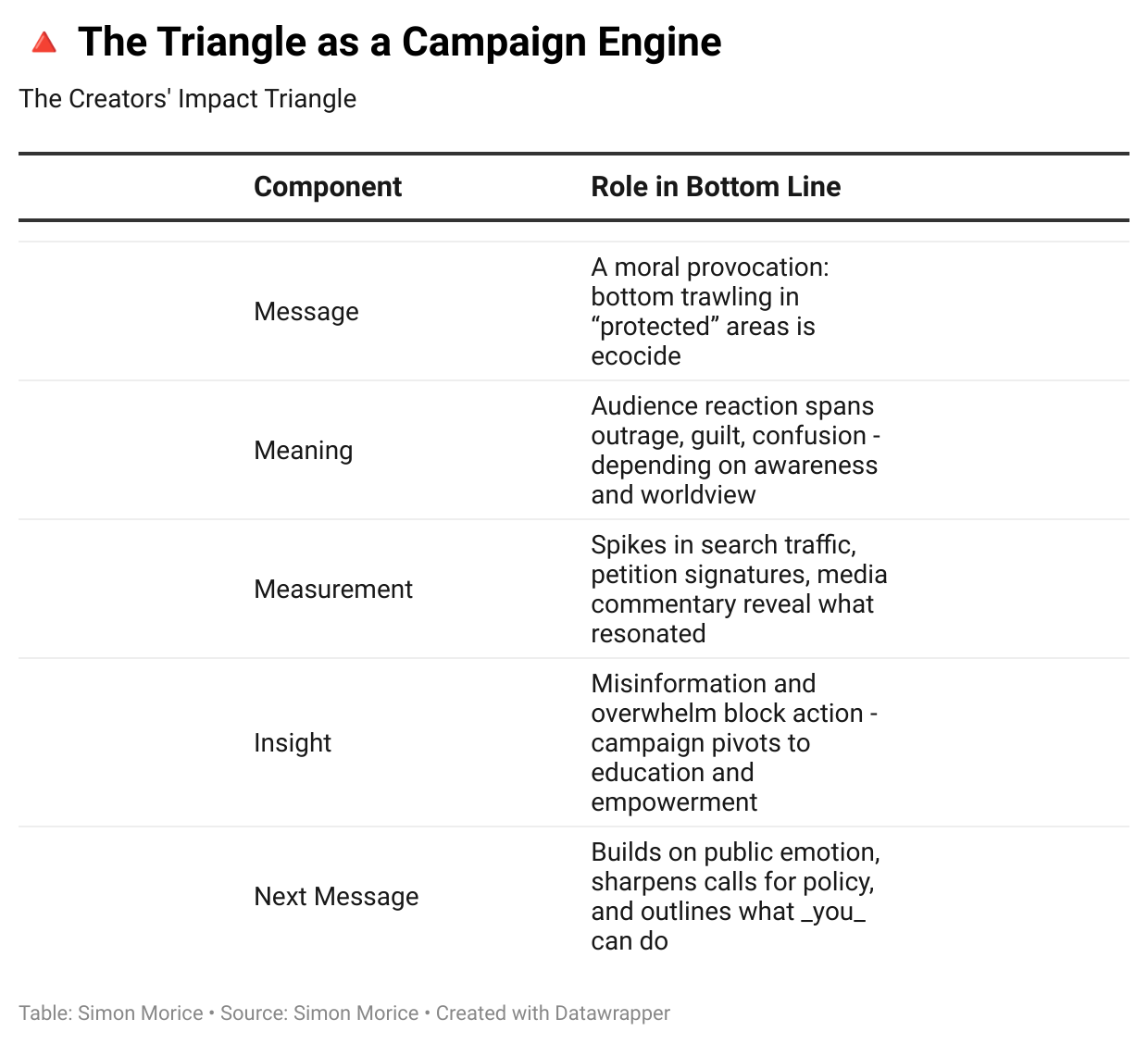The Creator’s Impact Triangle
A Model to Explain How Stories Turn Emotion into Action
In the shadow of Tyburn’s gallows, where crowds once gathered to watch the condemned speak their final truths, a strange tradition took root. Some called it morbid ritual, others a spark of freedom - for even at the edge of death, a person could say what they believed.
Centuries passed. The executions stopped, but the urge to speak remained. In 1872, the government made it official: a corner of Hyde Park was set aside where anyone - radical, preacher, dreamer, fool - could climb a box and speak their mind. No permission required. Just nerve.
One Sunday morning, a woman stepped up, her notes fluttering in the wind. She was no celebrity, just someone with something urgent to say. Around her, passers-by paused. Some cheered, some argued, others drifted off, unmoved. She didn’t flinch. Their reactions told her something. Not just who agreed - but who misunderstood. Where her meaning slipped. Where her message missed.
She came back the next week, tighter. Clearer. She knew now what caught attention, what opened ears, what shut people down. The words changed, but the purpose didn’t. She wasn’t chasing applause - she was chasing understanding.
Decades later, that triangle of ground still hosts voices, wild and wise. And online, it’s the same: we post our truths, meet confusion or connection, then try again. The gallows are gone. But the stakes - the need to be heard, to be understood - remain.
That’s what The Creator’s Impact Triangle is about. It’s not just how you speak - but how you learn from what’s heard.
Noise surrounds us, meaningful communication is not just about what you say - but how it’s heard, what it provokes, and where it leads.
To understand how creators - from filmmakers to campaigners - stay intentional, I’ve been developing a simple but powerful mental model: the Creator’s Impact Triangle.
It maps the three forces at play in any message that hopes to make a difference:
Message: Your intention - what you’re trying to say.
Meaning: What the audience takes from it.
Measurement: How you know what’s working.
These aren’t just abstract ideas - they form a cycle. The triangle spins. Message meets Meaning. Meaning yields Measurement. Measurement sharpens the next Message.
It’s a way of keeping your work aligned with your values, and your audience’s needs.
In practice, it looks something like this:
A Message’s Journey
Every story begins with desire.
In this one, the protagonist is Message - the part of us that burns to say something. To make a mark. To be understood. Message knows what it wants: to express truth, to provoke thought, to move others. But intention alone is not enough. The world doesn’t yield meaning on command.
So Message sets out. It crafts itself into shape - an article, a video, a film, a thread - and launches itself toward the unknown. At the far point of the triangle stands Meaning, quiet but powerful. Meaning doesn’t belong to Message; it belongs to those who receive it. The audience completes the message, not by agreeing, but by interpreting.
But here lies the first tension - the first conflict. Message believes it has spoken clearly. But Meaning doesn’t always respond the way Message expects. Sometimes it’s embraced. Other times, it’s misunderstood, twisted, or ignored. The connection between them is not a highway. It’s a mirror.
This edge - the path between Message and Meaning — is Reflection.
It shows not what was said, but what was heard. It doesn’t flatter. It reveals. And it hurts - because the message we thought was pure is suddenly full of gaps, shadows, ambiguity.
Meaning, though, doesn’t keep secrets. It leaves clues. Not directly, but in footprints - comments, silence, shares, bounce rates, rereads, drop-offs. Enter the third character: Measurement. Practical, analytical, sometimes cold - but never cruel. Measurement watches what people do in response to meaning. It takes the abstract and makes it legible.
This edge - from Meaning to Measurement - is Information.
It turns emotion into data, behaviour into signals. But it’s no oracle. It doesn’t explain. It only points.
And now, Message returns - older, wiser, and slightly humbled. It stares at Measurement’s findings and sees not judgment, but opportunity. These aren’t verdicts. They are insights - not into worth, but into resonance.
This final edge - from Measurement back to Message - is Insight.
Message now has a choice: ignore the signs and keep shouting, or listen, refine, adapt - not to manipulate, but to clarify. To say what it truly means, and to mean something worth saying.
And so the triangle completes a cycle.
Desire has met resistance. Conflict has revealed misalignment. Resolution arrives not as triumph, but as understanding. Message now knows what it didn’t know before - how to speak more truly, how to invite more deeply, how to navigate the uncertain terrain between sender and receiver.
And the triangle turns again. Because in the age of AI - and all its unintended consequences - what matters most isn’t the sheer volume of what we create.
It’s how well we listen to our own reflection.
It’s whether we dare to remain human in a loop that could easily turn robotic.
It’s whether we shape our tools not to go viral, but to go deep.
This is not a diagram. It’s a path.
Summary
Message → Meaning - You express your intention through content - a video, article, post, film, etc. Meaning belongs solely to the audience. They receive and interpret creators' messages. Meaning emerges, but it’s not always what you intended.
Meaning → Measurement - Audience reactions (comments, shares, time spent, bounce rate, silence) provide data. These are your measurement signals - not just numbers, but qualitative feedback.
Measurement → Message These insights feed your next message. You tune your intention, not to chase trends, but to sharpen resonance with the meaning you want to co-create.
Tools for Messages - Finding the Signal Before the Noise
AI Research Assistants – for sifting signal from noise on the web (e.g., ChatGPT, Claude, Perplexity, MindStudio agents).
Narrative Design Tools – e.g., Hero's Journey.Dramatica-based system, Muse Storytelling frameworks, etc.
Obsidian, LLMs, Notion, MindStudio, RelevanceAI, etc – as systems for developing, refining, and structuring story insights.
These tools help creators work with clarity of intention - not just “creating content,” but building stories that matter.
Tools for Meaning - Where the Magic Happens (You Can’t Control It)
Meaning Emerges in the Space Between)
Meaning is co-created - we set intentions, audiences complete the circuit.
Tools like multimodal workflows (text, video, audio) help us meet audiences where they are, not where we wish them to be.
Image-generation tools (like Midjourney or DALL·E) can fill in blanks - but only meaningfully if grounded in a well-shaped message.
Tools for Measurement - Tools That Listen Back
The Dashboard Isn’t the Enemy (When You Know What to Watch)
Google Analytics 4 (GA4) – reimagined as a tool of listening, not surveillance.
What engagement metrics mean (e.g., time on page, clickthroughs) and what they don’t.
The goal: a cockpit, not a casino - something that helps you fly intentionally not just chase dopamine hits.
Bottom Line - A Satirical Shock to the System
A real world example illustrates the potential of the creator's impact triangle. Blue Marine have created a short film that launched at the 2025 UN Ocean Conference. Bottom Line uses satire to highlight the unseen consequences of bottom trawling for fish. It stars Theo James and Stephen Fry, both ambassadors for Blue Marine. It could have just shown images of wasteful by catch, but they chose comedy:
So here is how it could work in the Creator's Impact Triangle:
Lessons for Any Creator
Bottom Line is a triangle-driven story in motion:
It starts with clarity of purpose - but doesn’t assume clarity of reception.
It embraces friction - measuring not just applause but confusion.
It iterates intelligently - always moving the message toward greater resonance and usefulness.
And crucially, it doesn’t stop at revelation. It moves viewers from awareness → emotion → possibility → action.
Because a story is only powerful when it leaves people not just informed - but equipped.
Bottom Line is exactly the kind of intentional storytelling I explore here on Media Unmade - not just how we craft stories, but how those stories behave in the world. The Creator’s Impact Triangle isn’t a gimmick; it’s a lens I return to in each post, whether I’m writing about AI, media collapse, or human-wildlife conflict at sea. Because the question isn’t “what should we say?” but “what should we mean - and how will we know if it’s working?” If that resonates, you’re in the right place.



